|
How many
lunar months (or orbits of Mercury) will there be until the E.T. crop
artists return to Earth? An “astronomical clock” was drawn to conclude
the 2019 summer season.
What might
this new crop picture near Stanton St. Bernard be trying to tell us? It
seems to be suggesting a “countdown” to some important E.T. contact
event in the near future. We may be able to learn beforehand when such a
historic event will take place, by studying carefully their crop-drawn
“astronomical clocks”.
Many
different crop pictures of this kind have appeared over the years,
starting in 1995 at Gander Down or Ovington Down, then continuing with
one or two examples in every summer since (for example
articles 15032019 ).
All of them seem to suggest some time in the years 2021 or 2022, for the
worldwide observation of a large “mothership UFO” which will end the
current cover-up. “The blind will see” (see for example
fringe2014n ).
Might this also be the “blue star Kachina” of Hopi legends?
At Stanton
Saint Bernard on August 24, 2019, the two cycles of time used in their
crop-drawn “astronomical clock” seem to refer to monthly phase cycles of
our Moon (29.5 days each), as well to solar orbits of the planet Mercury
(88 days each).
Mercury is
of great interest in August of 2019 because, in less than three months
on November 11, 2019, it will pass across the face of our Sun as seen
from Earth This rare event is known as “solar transit”. By an
interesting coincidence, 3 x 29.5 = 88.5 days for three monthly cycles
of our Moon (from “full” to “new” to “full”) match approximately the 88
days which it takes for Mercury to orbit once around our Sun. We can
understand quite a lot concerning this new crop picture, if we study it
carefully step-by-step in a logical, scientific fashion!
Mercury is
headed for transit across the face of our Sun (in the constellation
Libra) in less than three lunar months past August 24, 2019 on November
11, 2019
This is why
they drew three “lunar crescent” symbols for our Moon, arranged as a
“circular dial” within some kind of “astronomical clock”. Please see the
third crop picture shown on the right below, for August 24, 2019 at SSB
(Stanton Saint Bernard):
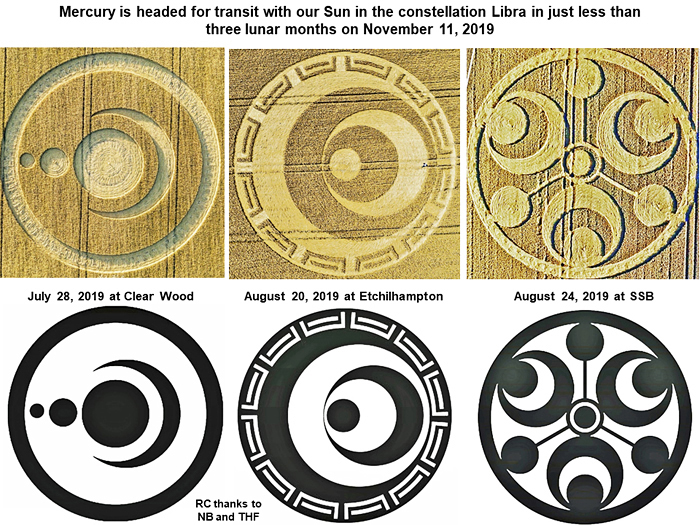
Two other
photographs shown above, on the left or at centre, refer to “Mercury
orbit” crop pictures which appeared at Clear Wood on July 28, 2019, or
at Etchilhampton on August 20, 2019 (see
clearwood articles
or
Etchilhampton articles ).
Why did the
crop artists switch suddenly from showing images of “Mercury orbit” or
“Mercury transit”, to showing a “clock” based on three lunar cycles of
our Moon? We will learn below in the next slide!
Three lunar
months of 29.5 days match approximately the time required for Mercury to
orbit once around our Sun in 88 days
Both crop
pictures which appeared on July 28, 2019 at Clear Wood, or on August 24,
2019 at Stanton Saint Barnard, showed approximately 88 “weaves” of
fallen wheat around the outside:
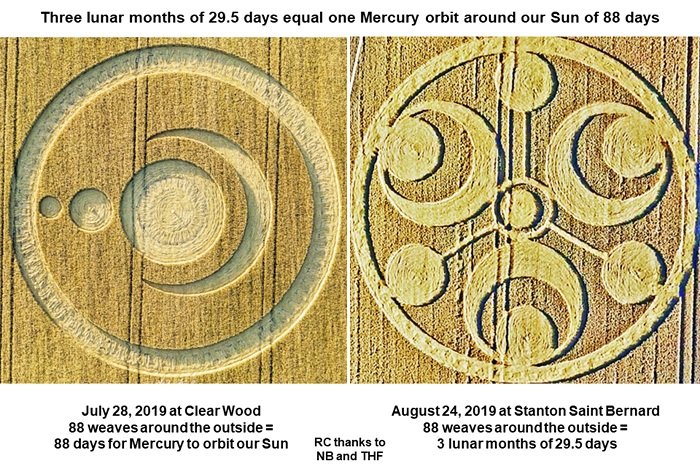
Please study
some aerial drone images shown on
stanton 2019
or
stanton videos
to see (or count) those outer “weaves” of fallen wheat more clearly.
The key
point here is that three lunar months take 3 x 29.5 = 88.5 days, while
one solar orbit of Mercury takes almost the same 88 days:
3 x 29.5 = 88.5 days for three cycles of our Moon = 88 days for one
solar orbit of Mercury
Do you
understand now what they are trying to tell us?
This new
crop picture near Stanton Saint Bernard in 2018 also resembles another
“spoked wheel” crop picture which appeared near West Knoyle in 2018
Both crop
pictures show “three-spoked turning wheels”. Both of these field images
suggest some kind of “clockwise-turning gear” or “clockwise-turning
clock”:
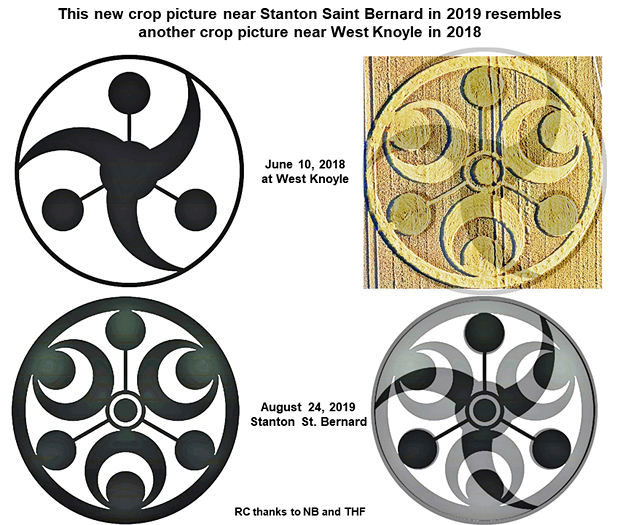
Right away,
we know that we can exclude anyone from having made these using “rope
and boards”, because the logistical difficulties for making them both
would be essentially impossible.
Still other
images were drawn in crops this summer of a “three-spoked wheel”, which
seems to be slowing down to a stop
Please see
the crop-drawn image shown at lower left below: what do the three blades
of a helicopter do when it comes in to land? Do they gradually slow
down?
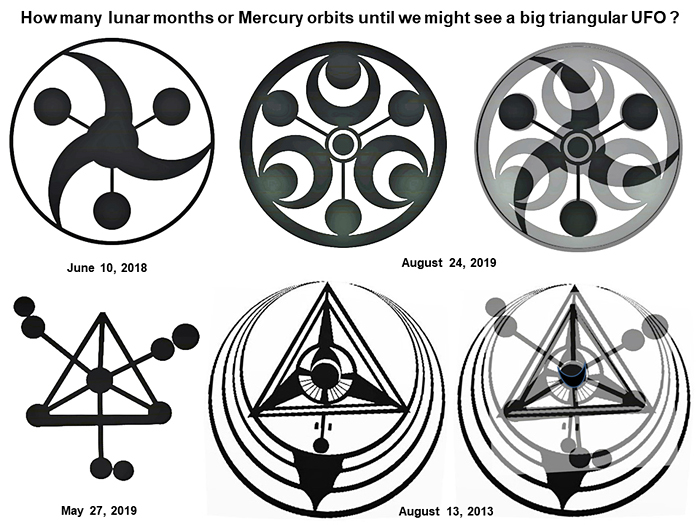
Next look
please to see how this crop-drawn image from May of 2019, shown at lower
left below, fits nicely into another famous “triangular UFO” crop
picture from August of 2013. By analogy, how long will it be until we
see a big triangular UFO slow down to enter Earth orbit?
How many
small circles do you see at the tip of each spinning “spoke” or “blade”?
0 > 1 > 2 years?
In the broad
landscape where this new crop picture was drawn, we can see the large,
schematic image of what might be a Hopi “Eagle Dancer”
When we
study the landscape near this new crop picture using Google Earth, at
latitude 51.366o N, longitude 1.865o W with “North
up”, we can see the large, schematic image of what might be a Hopi
“Eagle Dancer”, complete with “tail feathers” (see
www.youtube.com):
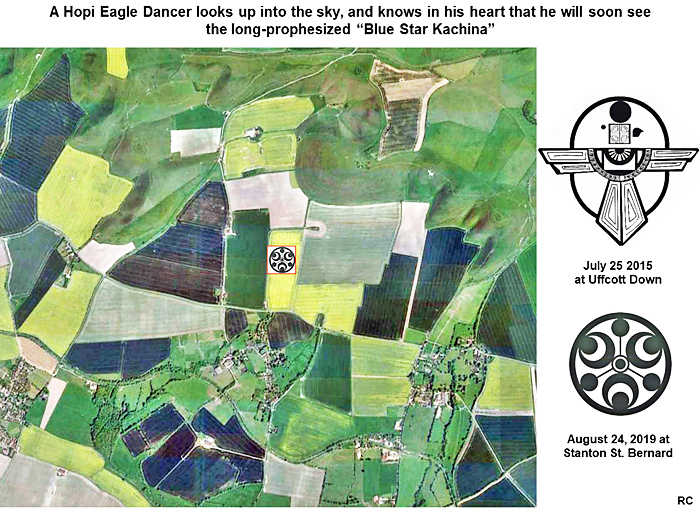
The new crop
picture of a “lunar clock” (marked by a red
square) was drawn close to his “heart”.
This amusing
landscape image from 2019 reminds us of a famous “Eagle” crop picture,
which appeared at Uffcott Down four years before on July 25, 2015 (shown
in the slide above at upper right).
The 2019
“Eagle Dancer” seems to be “looking up into the sky” to the right. Is he
looking perhaps for a long-prophesized “Blue Star Kachina”? According to
Hopi legends, a new “blue star”
will appear in our night sky, when some E.T. friends who used to
live on Earth with the Hopi, long ago, finally return to be with them
again.
We may see a
“friendly alien” get down from his “white horse” in “2” years
When we zoom
out using Google Earth, to ask where in the landscape this “Eagle
Dancer” might be “looking”, we can see (at latitude 51.389o
N, longitude 1.814o W, 3 km northeast) the schematic image of
a “small alien”, who has just gotten down from his “horse”. That alien
has lifted both “arms” above his “head”, and seems to be waving them at
us in friendship! Between those two schematic images in the landscape,
we can see the real Milk Hill “White Horse” (not shown here for
brevity).
Further to
the left at latitude 51.367o N, longitude 1.910o
W, 2 km west), we can see a large number “2” in the
landscape. Might some “blue-star kachina / white horse” (or E.T. contact
event) lie just 2 years into our future past the year 2019?
“How many
moons will it be?”
This new
crop picture near Stanton Saint Bernard on August 24, 2019 shows a
3-month “lunar clock”, with approximately 3 x 29.5 = 88.5 days per 360o
turn. The landscape “Eagle Dancer”, near whose “heart” it was drawn, may
be able to take some solace from their crop-drawn “clock”. It will help
him to count the time remaining!
“How many moons will it be?”
he
might be asking himself, until a great friend of the Hopi whom they call
“Pahana” (meaning “True White Brother”) will return to Earth:
"My people await Pahana, the lost White Brother, as do all of our
brothers in the land. He will not be like the white men we know now, who
are cruel and greedy. We were told of their coming long ago. Still we
await Pahana. He will bring with him the symbols, a missing piece of a
sacred tablet kept by our elders, which was given to him when he left.
That will identify him as our True White Brother.”
Why else would the crop artists draw a “3-month lunar clock” on the 24th
day of the 8th month of August, except to suggest “24 months”
or “8 turns” of their astronomical clock?
The specific
date of appearance of this “lunar clock” in crops as August 24, 2019, or
8 /
24, may suggest another clue as to when some historic event will
take place. Perhaps the month-number of “8”
suggests 8 turns of that
astronomical clock, while the day-number of
“24” suggests (8 x 3) = 24 months?
If this interpretation is correct, they would
seem to be telling us about the summer of 2021, for the sighting of some
new “blue star” or “mothership”, which the whole world will see.
Red Collie
(Dr. Horace R. Drew)
P.S. Many
thanks to The Hampshire Flyer and Nick Bull for excellent aerial-drone
photography, and to Crop Circle Centre for the line drawings used.
|